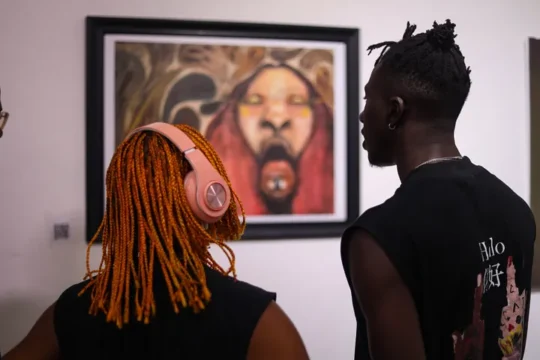How Does Art Work?: Analyzing Art Through Visual Language Part 1

In this series, we will explore the principles of design – how the Artist arranges and orchestrates the elements they use. Just as spoken language is based on phonemes, syntax, and semantics, visual art is based on elements and principles that, when used together, create works that communicate ideas and meaning to the viewer. We can think of them as the building blocks of an artwork’s composition: The Basic Elements (The Point, The Line, Mass, Shapes, and the Figure-Ground relationship) and Space, Value, Color, and Texture, which when put together create The Principle of Design (visual balance, repetition, scale and proportion, emphasis, time and motion, unity, and variety) – the organized layout of an image or object according to the principles of design or in other words, the principles of ‘visual language’.
These principles are based on sensory responses to visual input: elements APPEAR to have visual weight, movement, etc. They help govern what might occur when particular elements are arranged in a particular way. Using a chemistry analogy, they are the ways the elements “stick together” to make a “chemical” (in our case, an image). The basic elements of visual art language are the point, line, shapes, and the figure-ground relationship, which together form the mass of an artwork. A point marks a position in space, a concept fundamental to the creation of visual art. Lines connect these points in space, and their quality can suggest different states of being; for example, a jagged line might evoke tension, while a smooth curve suggests calm. Shapes, created by closed lines, are the foundation of an artwork’s mass, giving it form and solidity. The figure-ground relationship refers to the organization of shapes in an artwork, determining what is perceived as the figure (the focal point) and what is seen as the ground (the background).
For example, Pointillism is a famous art style used by many African Artists, including popular Painter Eghosa Akenbor. He and others utilizing this style created paintings by juxtaposing points – or dots – of color that intermingled optically to form lines, shapes, and forms within a composition. Look at a detail from Eghosa’s Design (Series collection)2023 to see how this works. His intricate piece is a testament to the pointillist style and aesthetic. Its creation using mixed mediums was a painstaking process, which speaks to fresh ways of thinking about color and form. And how he uses intricate smaller points to communicate a bigger picture.

Design (Series collection)2023
There are many types of lines, all characterized by their length being greater than their width. Lines can be static or dynamic, depending on how the artist uses them. They help determine the motion, direction, and energy of a work of art. We see lines around us in our daily lives; telephone wires, tree branches, jet contrails, and winding roads are just a few examples. Nigerian artist Olaolu ‘Slawn’ makes great use of this element in his art style. In his painting Self Portrait, 2022, we see how he uses thick, bold lines that create a sense of immediacy and raw energy. These lines contribute to the overall energetic and vibrant feel of his artwork. Slawn’s use of lines in this piece contributes to the overall visual impact of his artwork. The exaggerated lines create a sense of movement, energy, and emotion, drawing the viewer into the artwork and inviting them to explore the artist’s unique perspective.
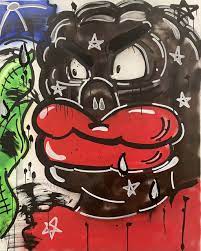
Self Portrait, 2022 by Olaolu ‘Slawn’
Mass, or form, refers to a shape or three-dimensional volume that has or gives the illusion of having weight, density, or bulk. Notice the distinction between two- and three-dimensional objects: a shape is, by definition, flat but takes on the illusion of mass through shading with the elements of value or color. In three dimensions, a mass is an actual object that takes up space. The Ijamido statue located in Ogun state, Nigeria epitomizes the characteristics of three-dimensional mass. Carved from stone with exaggerated physicality to appear bigger than life, the work stands heavily against the space around it. The sculpture balances the massive sculpture with his treatment of the subject matter. The goddess stands vertically holding a gourd which she pours onto the ground representing the blessing she brings to the town and its people. Although actual mass and form are physical attributes of any three-dimensional art, they are manifested differently depending on the culture they are produced. For example, the Ijamido statue is done in a more traditional Western European style which is known for its realistic styles. In contrast, look at the figurative sculpture from the Cameroon culture below to see how stylistic changes make a difference in the form. The sculpture Gedenkfigur Kamerum is carved from wood, which is generally more available to artists in sub-Saharan Africa than marble. Moreover, the Cameroon figure stands upright and frontal to the viewer and is carved without the amount of descriptive detail seen in the Ijamido Statue work. Yet, the unknown African artist still gives the figure an astonishing amount of dramatic character that energizes the space around it.
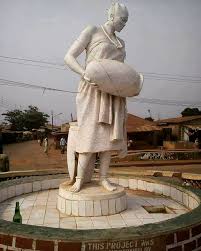
Ijamido Statue in Ogun state, Nigeria
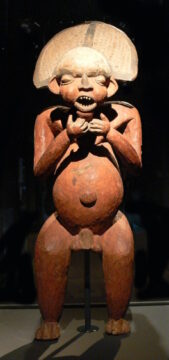
Gedenkfigur Kamerum. Berlin-Dahlem
When discussing shapes and the figure-ground relationship we first need to define what a shape is, A shape is defined as an enclosed area in two dimensions. By definition, shapes are always implied and flat. They can be created in many ways, the simplest by enclosing an area with an outline. They can also be made by surrounding an area with other shapes or placing different textures next to each other – for instance, the shape of an island surrounded by water. Because they are more complex than lines, shapes do much of the heavy lifting in arranging compositions. Shapes animate figure-ground relationships. We visually determine positive shapes (the figure) and negative shapes (the ground). One way to understand this is to open your hand and spread your fingers apart. Your hand is the positive shape, and the space around it becomes the negative shape. You can also see this in the example below. In this piece, Hard to Get, 2020 by Osholo Precious the figure(shape) formed by the black outline becomes positive because it’s enclosed. The darker area around it is negative.
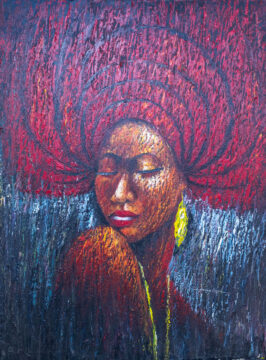
Hard to Get, 2020 by Osholo Precious



